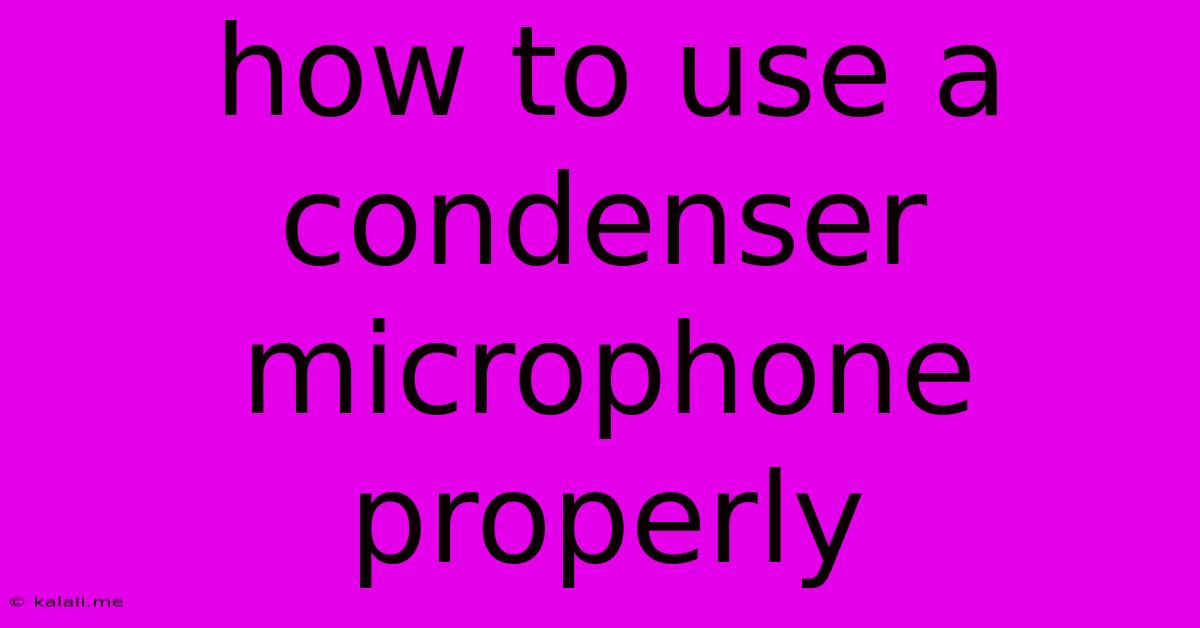How To Use A Condenser Microphone Properly
Kalali
Jun 07, 2025 · 3 min read

Table of Contents
How to Use a Condenser Microphone Properly: A Comprehensive Guide
Condenser microphones, known for their sensitivity and clarity, are a staple in professional recording studios and increasingly popular among home recording enthusiasts. However, their delicate nature and specific requirements mean that understanding how to use them properly is crucial for achieving optimal sound quality. This guide will walk you through the essential steps, from setup to maintenance, ensuring you get the most out of your condenser microphone.
Understanding Condenser Microphones: Unlike dynamic microphones, condenser mics require phantom power (+48V) to operate. This power is supplied by your audio interface or mixing console. They're highly sensitive to subtle nuances in sound, making them ideal for capturing vocals, acoustic instruments, and other delicate sounds. But this sensitivity also means they're more susceptible to unwanted noise and handling issues.
Setting Up Your Condenser Microphone: A Step-by-Step Approach
-
Phantom Power: Before connecting anything, ensure your audio interface or mixer is set to provide +48V phantom power. Failing to do this will not only prevent the microphone from working but could potentially damage it. Check your equipment's manual if you're unsure how to enable phantom power.
-
Choosing the Right Cable: Use a high-quality, low-noise XLR cable to connect your microphone to your audio interface. Cheap cables can introduce unwanted hum and noise.
-
Microphone Placement: Condenser microphone placement is crucial. Experiment with different distances and angles to find the sweet spot for your sound source. Generally, a closer proximity will result in a more intimate and detailed sound, while further away will offer a more natural and spacious sound. Consider using a pop filter to reduce plosives (hard consonant sounds like 'p' and 'b') which can overload the microphone and create distortion.
-
Microphone Positioning Techniques: For vocals, consider the cardioid polar pattern to minimize background noise. Experiment with the angle to find the best capture of your vocal performance. For instruments, consider the acoustic properties of the room and the instrument itself when choosing the placement.
-
Gain Staging: Adjust the gain (input level) on your audio interface carefully. Avoid setting the gain too high, which can lead to clipping (distortion) and unwanted noise. Aim for a level that provides a good signal without peaking.
-
Monitoring: Always monitor your audio levels during recording to prevent clipping. Visual monitoring tools on your audio interface or recording software will help you avoid this problem.
Advanced Techniques for Optimal Sound
-
Shock Mounting: Use a shock mount to isolate your microphone from vibrations and handling noise. This is especially important for sensitive condenser microphones.
-
Acoustic Treatment: The acoustic environment significantly impacts the sound quality. Treat your recording space with sound-absorbing materials to minimize reflections and unwanted room noise. Consider using bass traps in corners to reduce low-frequency buildup.
Maintaining Your Condenser Microphone
-
Cleaning: Gently clean your microphone's capsule with a soft brush to remove dust and debris. Avoid using harsh chemicals or abrasive materials.
-
Storage: Store your microphone in its original case or a protective bag when not in use to protect it from damage.
-
Regular Inspection: Periodically inspect the microphone for any signs of damage, such as dents or loose parts.
By following these steps, you'll be well on your way to capturing high-quality audio with your condenser microphone. Remember that practice and experimentation are key to mastering microphone technique. Don't be afraid to experiment with different settings and placements to find what works best for your specific needs and sound source. Happy recording!
Latest Posts
Latest Posts
-
How To Turn On Headlamp In Fallout 76
Jun 07, 2025
-
Locus Of Points Equidistant From A Point And A Circle
Jun 07, 2025
-
How To Find Out Where A Transaction Came From
Jun 07, 2025
-
How Do You Say Pecan In Spanish
Jun 07, 2025
-
Burning A Candle At Both Ends
Jun 07, 2025
Related Post
Thank you for visiting our website which covers about How To Use A Condenser Microphone Properly . We hope the information provided has been useful to you. Feel free to contact us if you have any questions or need further assistance. See you next time and don't miss to bookmark.